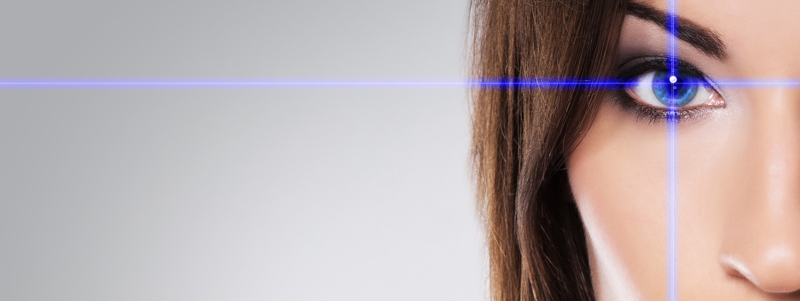
LASIK, an acronym for Laser-Assisted In Situ Keratomileusis, is a refractive procedure that reshapes the cornea to correct nearsightedness, farsightedness and astigmatism. It is the most common type of refractive surgery. Using targeted laser beam energy, the LASIK procedure reshapes the cornea so that light rays are focused more precisely on the retina, producing clear, sharp vision.
Candidates Eligible For LASIK
LASIK is considered a safe procedure, yet it is not ideal for everyone. A thorough medical evaluation of the patient’s eyes must be performed to determine whether the LASIK procedure is appropriate. Good candidates for laser vision correction are patients who:
- Are over 18 years old
- Not pregnant or nursing
- In general good health
- Have had stable vision for at least 6 months
- Have healthy corneal tissue, thick enough for a flap
- Have refractive errors that fall within the treatable range
It is also important for patients to fully understand the details and risks of the procedure, and to maintain realistic expectations for the outcome.
Benefits Of LASIK Eye Surgery

LASIK surgery has the advantage of being a short procedure that results in permanent vision improvement. Most patients who choose to undergo LASIK achieve clear vision without corrective lenses while also benefiting from minimal downtime and only mild post-operative discomfort.
The LASIK Procedure
LASIK laser vision correction is performed on an outpatient basis using only numbing eye drops to reduce any potential discomfort. The entire surgery takes less than 30 minutes to perform, although patients can expect to spend a few hours at the doctor’s office. If requested, patients can receive an oral sedative prior to surgery to reduce any anxieties about the procedure.
During the LASIK procedure, the patient lies down in a reclining chair as the doctor positions the laser precisely over the eye. A speculum is used to keep the eye open while the eye is cleaned and anesthetic eye drops are administered. A corneal flap is created with a laser. The surgeon gently lifts the surface of the cornea aside, enabling the excimer laser to reshape the curvature of the cornea.
The excimer laser delivers customized pulses of light energy based on each patient’s prescription. The measurements for customization are determined prior to surgery, with the precise positioning confirmed prior to the start of the procedure. The second eye is treated immediately after the first. Following the surgery, the patient is provided with a protective shield to protect the eyes from bright lights.
Risks Of LASIK
Any surgical procedure carries some risks, and patients should be aware that changes to the cornea made during LASIK cannot be reversed. Nonetheless, LASIK surgery is considered safe for most eligible patients. While rare, complications may occur after the procedure, including:
- Undercorrection or overcorrection of vision
- Astigmatism
- Dry eyes
- Flap complications
- Postsurgical infection
- Increased sensitivity to light
- Visual problems, such as halos or night glare
- Fluctuating vision
See What Our Patients Are Saying!
Google Reviews
“My family and I have been going to Dr. Parker at Ungricht Parker Eye Associates for years now, and what keeps us going back is the care we get and the friendliness of every employee there . Dr. Parker is so thorough with his exams, making sure that nothing is over looked and that any eye problems we have had are taken care of. They also make sure that we are up to date on all of our eye exams, and making sure we have the correct contacts/eye wear. The front desk staff is so friendly I feel like they know me and my family so well, and when I come in without my kids, they ask all about them. Every time I go there it is a pleasant experience, but also one that I know that I am being well taken care of. I highly recommend using Dr. Parker!” – Nick P.“I’ve gone to Dr. Gayer for years, he is exceptionally through and always listens to any concerns I’ve had. He also is so kind and a super geniueine human, the best eye doctor I’ve ever had!” – Maddison D.
Recovery After The LASIK Surgery Procedure
After LASIK, patients rest in the ophthalmologist’s office for a short time before having someone else escort them home. Medication may be prescribed to relieve any discomfort experienced during the first 24 to 48 hours after surgery, but most patients tolerate this procedure well. The doctor will likely recommend a few hours of rest after treatment. Most patients are able to return to work and other regular activities the very next day. Patients who have undergone LASIK are instructed to avoid strenuous activities for at least a week.
Typically, patients experience a significant improvement in their vision immediately after the procedure, but the full benefits of LASIK may not be apparent for several months. While patients can achieve clear vision from LASIK, this procedure does not prevent the development of presbyopia, the age-related vision changes that occur after the age of 40. Many patients will need reading glasses for this condition, but their distance vision will remain clear.
Schedule Your Appointment Today!
For more information on LASIK or to schedule an appointment with one of our expert eye surgeons, call Ungricht Parker Eye Associates today at 801-314-4420.
